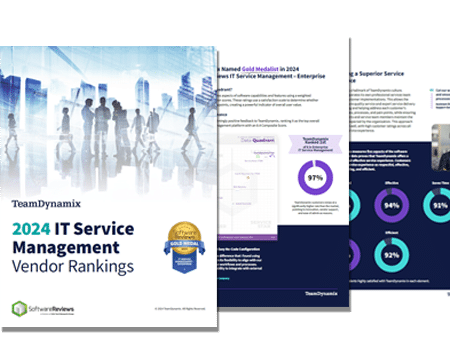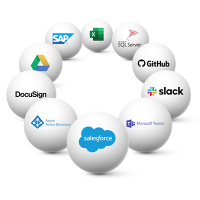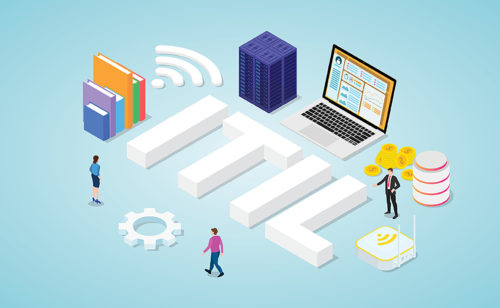
Companies Say They Need Automation, Easy-to-Manage ITSM
A study from Information Week and TeamDynamix shows companies are looking to invest in IT Service Management (ITSM) software that is simple to administer and

The Info-Tech ranking report offers a unique view of the market based entirely on in-depth customer interviews. Download the Info-Tech ITSM Quadrant and Customer Viewpoint report today.

We’ll show you some of our best situations and show you exactly how to execute them to get immediate results. The best part is, iPaaS tools often feature easy-to-use click and drag functionality, meaning you don’t need a dedicated employee building integrations and workflows.

System Integrators, Value Added Resellers, Technology Providers, and Buying Consortiums can benefit from a partnership with TeamDynamix.

The Info-Tech ranking report offers a unique view of the market based entirely on in-depth customer interviews. Download the Info-Tech ITSM Quadrant and Customer Viewpoint report to gain a better understanding of key vendor strengths and emerging market requirements.
Digital transformation is a key driver of success in today’s competitive business climate. To get ahead, companies must incorporate the latest technology into their systems and processes, or face being left behind. In fact, Gartner predicts that IT spending in 2023 will total $4.5 trillion – an increase of 2.4 percent from 2022.
An integration and automation platform (iPaaS) is a foundational tool for digital transformation success, and if Gartner’s IT spend predictions for 2023 are correct, it’s likely many CIOs and IT leaders are looking to invest in iPaaS and other tools to support their digital transformation initiatives.
So why is iPaaS so critical for digital transformation success?
iPaaS allows you to integrate different applications and systems, enabling businesses to share data across all departments which creates an efficient environment for collaboration and a better customer or end-user experience.
Additionally, automation eliminates manual tasks such as data entry, freeing up resources and personnel for value-added activities that truly drive growth. And the benefits of automation and integration aren’t limited to IT. With a no-code iPaaS tool, you can enable integration and automation in every department without needing to rely on internal (or third-party) IT teams to build out these functions and features.
Managing user permissions and resetting passwords can often be tedious tasks for IT teams. In fact, a recent study from InformationWeek found that:
With automation in place using iPaaS, these types of repetitive tasks become simple processes that take very little time or effort, ensuring consistent policy adherence across the organization. Automated processes also reduce human error which can lead to security risks or other potentially costly mistakes if not caught in time.
In addition to saving time and resources, tools like iPaaS can improve employee morale – something that is critical in retaining top talent, especially in IT, and successfully pushing digital transformation efforts forward.
According to Gartner, job vacancy rates are continuing to increase in IT and there is high competition for talent as companies continue to struggle to hire for IT positions. There are a few reasons for this, Gartner states, “High competition for talent is challenging CIOs to hire skilled IT staff, limiting growth for companies who struggle to scale without the requisite talent.”
In addition, John-David Lovelock, Distinguished VP Analyst at Gartner, said, “Skilled IT workers are migrating away from the enterprise CIO towards technology and service providers (TSPs) who can keep up with increased wage requirements, development opportunities and career prospects.”
And this isn’t surprising. The InformationWeek study found that 90 percent of respondents felt repetitive manual IT tasks directly contributed to low morale and attrition within their IT organizations.
When asked to rank the types of tasks they found to be time-wasting and to contribute the most to poor morale they listed password resets, IT ticket cleanup, onboarding/offboarding employees, managing credentials and software provisioning – all tasks that can be automated through iPaaS.
At Pima County, Mark Hayes, information technology leader for the county, said reducing toil and improving IT morale was a driving factor for investing in iPaaS. Hayes and his team recently implemented TeamDynamix iPaaS and IT Service Management and have had positive results so far.
“People feel so much more empowered and have so much more worth when they are doing things that are intellectually rigorous and challenging versus when they are just repeating the same mechanical actions over and over and over with very little thought,” he said.
“[The IT help desk] is our entry point to our entire IT organization, and we want our employees to graduate out of this area into other roles within our organization – network technicians, client services, desktop technicians, developers and project managers,” Hayes continued. “If all they’re doing is handling tickets and doing the same mundane, manual tasks over and over that’s not particularly great training. So, investing in tools that allow our employees to engage in meaningful work is something that’s important to us as an overall IT organization.”
And while Pima County is starting its digital transformation in IT, Hayes is looking to showcase the benefits they are seeing so they can deploy integration and automation through iPaaS to other departments as well.
“The drudgery of working through mundane, repetitive tasks doesn’t exist just in IT,” Hayes said. “I think the more we can reduce toil within the departments that we support, the more people are going to buy in and understand the value of what we’re trying to achieve. There’s nothing like success to breed more success, and once other departments see the benefits they’re going to want these tools too.”
Investing in a no-code iPaaS platform is one of the best ways to kickstart your digital transformation efforts. By empowering employees experienced with technology (not just IT teams) to build out integrations and automated workflows quickly – without needing to write code or scripts – they can save time and resources while reducing the burden on IT.
TeamDynamix’s iPaaS platform centralizes all integrations into one hub with a library of connectors to common systems such as Workday, Oracle, your IT Service Management (ITSM) platform, Salesforce, the Active Directory, Azure, and hundreds more, as well as any APIs.
With all systems connected and data points now secured in one spot, end-users can leverage the platform to move data, transform data and build out automation and workflows using a visual flow builder (that’s drag-and-drop) that can be triggered from a field change, form fill or any number of actions.
With TeamDynamix – you get the added ability to combine your TeamDynamix ITSM tool with iPaaS and Project Portfolio Management (PPM), all on a single platform – giving even more visibility into all of the work and projects being done throughout your entire organization.
Another benefit of using iPaaS is that you don’t need to worry about homegrown scripts or automations – while these might seem like a quick fix to solve the issue of automating repetitive tasks, they often bring a number of security risks and can be difficult to maintain as an organization continues to grow.
In addition, building and maintaining these homegrown integrations and automations can take up even more time – adding to backlogs that can cause project delays and result in unhappy customers.
With iPaaS in place, IT, in many cases, will see a decrease or elimination of integration backlogs which means higher-priority and business-critical projects can remain on schedule and businesses stay competitive in their respective markets.
Curious about the impact iPaaS can have on relieving IT resource drain, read the market study from InformationWeek: State of IT – Resource Drain.
To learn more about the benefits of no-code iPaaS and its impact on digital transformation we recommend checking out our white paper: Unifying Today’s Enterprise with a Codeless Integration and Automation Platform.

A study from Information Week and TeamDynamix shows companies are looking to invest in IT Service Management (ITSM) software that is simple to administer and

When it comes to improving IT Service Management (ITSM) maturity, many organizations turn to ITIL – a framework that guides users through a process-based approach

Enterprise Service Management (ESM) is the practice of extending IT Service Management (ITSM) principles beyond the IT department to other areas of an organization. ESM
TeamDynamix’s award-winning SaaS cloud solution offers IT Service and Project Management together on one platform with enterprise integration and automation.
[email protected]
(877) 752-6196
Contact Us
